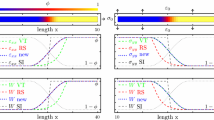Abstract
A computational scheme for the determination of the interface in a strain-induced phase-transition problem for an elastic bar is proposed. The algorithm is based on the material force notion and more specifically on the simultaneous solution of equilibrium equations for the physical and material forces. The weak form of both equations is derived with the aid of a variational principle that accounts for the variations of the dependent and the independent variables. The whole scheme concludes in a nonlinear algebraic system which is numerically solved by the Newton method. The numerical results thus derived seem to be quite encouraging for further application of the concept of material forces in computations related to phase transition problems. The austenite–martensite transformation could be a possible application of the proposed model.
Similar content being viewed by others
References
Abeyaratne R., Knowles J.K. (1990) On the driving traction acting on a surface of strain discontinuity in a continuum. J. Mech. Phys. Solid 38, 345–360
Abeyaratne R., Bhattacharya K., Knowles J.K. (2001) Strain–Energy functions with multiple local minima: Modeling phase transformations using finite thermoelasticity. In: Fu Y., Ogden R.W. (eds) Nonlinear Elasticity: Theory and Applications. Cambridge Univ. Press, Cambridge, pp. 433–490
Askes J., Kuhl E., Steinmann P. (2004) An ALE formulation based on spatial and material settings of continuum mechanics. Part 2: classification and applications. Comput. Methods Appl. Mech. Eng. 193, 4223–4245
Balassas, K.G., Kalpakides, V.K.: The use of material forces in a phase transition problem (submitted for publication to Comput. Methods Appl. Mech. Eng.)
Balassas K.G., Kalpakides V.K., Stavroulakis G.E. (2005) The use of material forces to improve the finite element solution in elasticity. J. Mech. Behav. Mat. 16, 269–278
Braun M. (1997) Configurational forces induced by finite-element discretization. Proc. Estonian Acad. Sci. Phys. Math. 46, 24–31
Edelen D.J.D. (1981) Aspects of variational arguments in the theory of elasticity – fact and folklore. Int. J. Solids Struct. 17, 729–740
Ericksen J.L. (1975) Equilibrium of bars. J. Elast. 5, 191–201
Gurtin, M.E. (2000) Configurational Forces as Basic Concepts of Continuum Physics. In: Applied Mathematical Sciences, vol. 37, Springer, Berlin Heidelberg New York
Kalpakides V.K., Balassas K.G. (2005) The Inverse deformation mapping in the finite element method. Phil. Mag. 85, 4257–4275
Kienzler R., Herrmann G. (2000) Mechanics in Material Space with applications to defect and Fracture Mechanics. Springer, Berlin Heidelberg New York
Kienzler R., Herrmann G. (2002) Fracture criteria based on local properties of the Eshelby tensor. Mech. Res. Commun. 29, 521–527
Kuhl E., Steinmann P. (2004) On the impact of configurational mechanics on computational mechanics. In: Kalpakides V.K., Maugin G.A. (eds) Configurational Mechanics. Balkema, Leiden, pp. 15–29
Kuhl E., Denzer R., Barth F.J., Steinmann P. (2004) Application of the material force method to thermo-hyperelasticity. Comput. Methods Appl. Eng. 193, 3303–3325
Maugin G.A. (1993) Material Inhomogeneities in Elasticity. Chapman and Hall, London
Maugin G.A. (2000) Geometry of material space: its consequences in modern computational means. Tech. Mech. 20, 95–104
Maugin G.A., Kalpakides V.K. (2002) A Hamiltonian formulation of elasticity and thermoelasticity. J. Phys. A: Math. Gen. 35, 10775–10788
Mueller R., Maugin G.A. (2002) On material forces and finite element discretization. Comp. Mech. 29, 52–60
Mueller R., Kolling S., Gross D. (2002) On configurational forces in the context of the finite element method. Int. J. Numer. Methods Eng. 53, 1557–1574
Mueller R., Gross D., Maugin G.A. (2004) Use of material forces in adaptive finite element methods. Comp. Mech. 33, 421–434
Oden J.T. (1972) Finite Elements of Nonlinear Continua. McGraw–Hill, New York, pp. 284–292
Steinmann P. (2002) On spatial and material settings of hyperelastostatic crystal defects. J. Mech. Phys. Solids 50, 1743–1766
Steinmann P., Ackermann D., Barth F.J. (2001) Applications of material forces to hyperelastic fracture mechanics. Part II. Computational setting. Int. J. Solids Struct. 38, 5509–5526
Thoutireddy, P. (2003) Variational arbitrary Lagrangian–Eulerian method. Ph.D. Thesis, California Institute of Technology, Pasadena, California
Author information
Authors and Affiliations
Corresponding author
Rights and permissions
About this article
Cite this article
Kalpakides, V.K., Balassas, K.G. & Massalas, C.V. Material forces and phase transitions in elasticity. Arch Appl Mech 77, 135–146 (2007). https://doi.org/10.1007/s00419-006-0071-3
Received:
Accepted:
Published:
Issue Date:
DOI: https://doi.org/10.1007/s00419-006-0071-3



